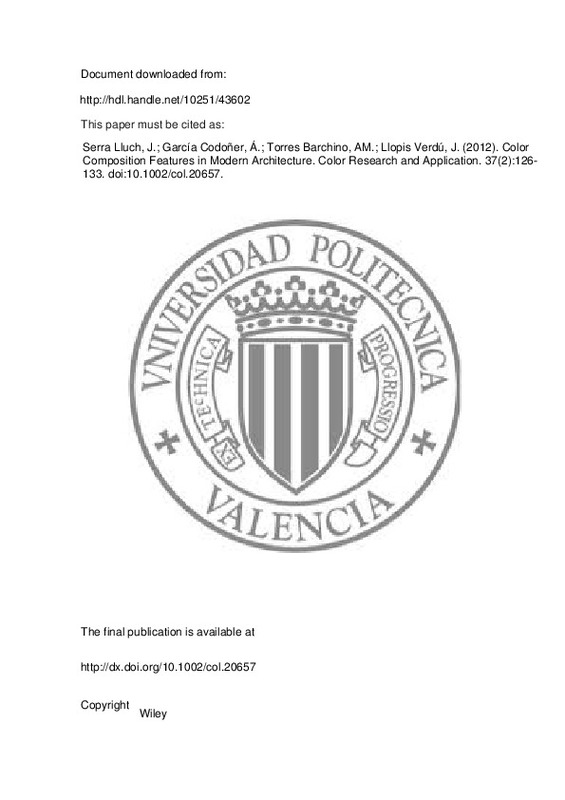JavaScript is disabled for your browser. Some features of this site may not work without it.
Buscar en RiuNet
Listar
Mi cuenta
Estadísticas
Ayuda RiuNet
Admin. UPV
Color Composition Features in Modern Architecture
Mostrar el registro sencillo del ítem
Ficheros en el ítem
| dc.contributor.author | Serra Lluch, Juan
|
es_ES |
| dc.contributor.author | García Codoñer, Ángela
|
es_ES |
| dc.contributor.author | Torres Barchino, Ana María
|
es_ES |
| dc.contributor.author | Llopis Verdú, Jorge
|
es_ES |
| dc.date.accessioned | 2014-10-27T15:00:55Z | |
| dc.date.available | 2014-10-27T15:00:55Z | |
| dc.date.issued | 2012-04 | |
| dc.identifier.issn | 0361-2317 | |
| dc.identifier.uri | http://hdl.handle.net/10251/43602 | |
| dc.description | This is the pre-peer reviewed version of the following article: Serra, J., García, Á., Torres, A. and Llopis, J. (2012), Color composition features in modern architecture. Color Res. Appl., 37: 126–133. doi: 10.1002/col.20657 which has been published in final form at http://onlinelibrary.wiley.com/doi/10.1002/col.20657/abstract;jsessionid=32EFF118A442D8103D1391F9485EFF4F.f04t02 | es_ES |
| dc.description.abstract | The color composition in modern architecture has been often characterized in a simplistic manner. In fact, this is a complex phenomenon to be studied because of the disparity of proposals and the uniqueness of the architects involved. This research starts with a comparative study of three of the most relevant color composition systems in the first half of the 20th century (Purism and Le Corbusier, Expressionism and Taut, Neoplasticism and Rietveld), and aims to find common characteristics among them, discussing the validity of some widespread ideas about it, such as the prominence of white hues, the use of "flat colors," or the conception of color during the ideation phase. We propose and demonstrate three principles that are not categorical about the color composition in modern architecture: it limits the variety of hues; it not only uses white color but also displays color to conform shapes and to transform them; color has ethical connotations and not only aesthetic ones. Copyright © 2011 Wiley Periodicals, Inc. | es_ES |
| dc.language | Inglés | es_ES |
| dc.publisher | Wiley | es_ES |
| dc.relation.ispartof | Color Research and Application | es_ES |
| dc.rights | Reserva de todos los derechos | es_ES |
| dc.subject | Architecture | es_ES |
| dc.subject | Color composition | es_ES |
| dc.subject | Color theory | es_ES |
| dc.subject | Modern architecture | es_ES |
| dc.subject | 20th century | es_ES |
| dc.subject | Comparative studies | es_ES |
| dc.subject.classification | EXPRESION GRAFICA ARQUITECTONICA | es_ES |
| dc.title | Color Composition Features in Modern Architecture | es_ES |
| dc.type | Artículo | es_ES |
| dc.identifier.doi | 10.1002/col.20657. | |
| dc.rights.accessRights | Abierto | es_ES |
| dc.contributor.affiliation | Universitat Politècnica de València. Departamento de Expresión Gráfica Arquitectónica - Departament d'Expressió Gràfica Arquitectònica | es_ES |
| dc.description.bibliographicCitation | Serra Lluch, J.; García Codoñer, Á.; Torres Barchino, AM.; Llopis Verdú, J. (2012). Color Composition Features in Modern Architecture. Color Research and Application. 37(2):126-133. doi:10.1002/col.20657 | es_ES |
| dc.description.accrualMethod | S | es_ES |
| dc.relation.publisherversion | http://dx.doi.org/10.1002/col.20657 | es_ES |
| dc.description.upvformatpinicio | 126 | es_ES |
| dc.description.upvformatpfin | 133 | es_ES |
| dc.type.version | info:eu-repo/semantics/publishedVersion | es_ES |
| dc.description.volume | 37 | es_ES |
| dc.description.issue | 2 | es_ES |
| dc.relation.senia | 216878 | |
| dc.subject.asignatura | Color y diseño de espacios: ergonomía visual y accesibilidad 32361 / B - Máster universitario en arquitectura avanzada, paisaje, urbanismo y diseño 2158 | es_ES |
| dc.subject.asignatura | Color y diseño de espacios: ergonomía visual y accesibilidad 32361 / W - Programa de doctorado en arquitectura, edificación, urbanística y paisaje 2214 | es_ES |
| dc.subject.asignatura | Diseño gráfico y cromático para el espacio arquitectónico y urbano 34159 / B - Máster universitario en arquitectura 2261 | es_ES |







![[Cerrado]](/themes/UPV/images/candado.png)

